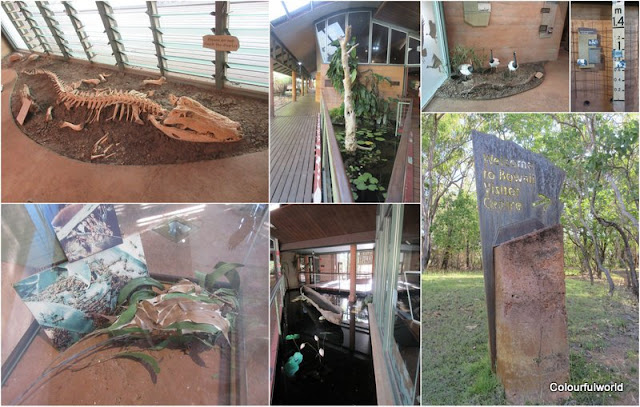 |
| Panoramic view of the river and one of the boats while we were waiting to depart |
 |
| The moon was still shining just before we departed on the cruise |
Kakadu was placed on the UNESCO World Heritage List in 1992, in recognition of its cultural and natural value. It is home to an incredible 2,000 plant species, 280 types of birds (around one-third of all Australian bird species) and about one-fifth of all Australian mammals.
The landlocked Yellow Water Billabong flows into the South Alligator River, which is made up of swamps, floodplains and river channels. Yellow Water Cruises, is an Indigenous owned Company with exclusive use of the billabong and they run 6 cruises a day from sunrise to sunset, all year long.
Once passengers filled the 2 boats we departed. Soon we spotted the first salt-water crocodile in the water. During 2 hours, we drifted slowly along the still waters, while our very humorous half-Aboriginal tour guide pointed out crocs, various birds, wild animals and local flora. I have never been into bird spotting, but I really enjoyed seeing so many different species in their habitat.
Hope I got their names right!
 |
| Crocs in and out of the water |
 |
| Buffalo, Plumed Whistling-duck, Egret, Cormorant |
 |
| Nakeen Night Heron, Comb-crested Jacana?, Great blue heron?, Brolga |
 |
| Black necked stork (jabiru), White bellied Sea Eagle, Azure kingfisher, Magpie goose |
On or return to Cooinda Lodge we had our Continental breakfast.
This cute Jabiru was a regular in the breakfast area, jumping onto tables to pick on leftovers as soon as guests departed - they usually eat fish, molluscs and amphibians, so not sure what appealed to him in eggs, toast, pancakes?
At around 9am the group got on the tour bus on the way to Maguk or Barramundi Gorge Falls, 14km away.
The road includes 12km of unsealed corrugated road, more suitable for 4wd. To reach the beautiful crystal clear pool fed by a waterfall and surrounded by steep gorge walls, you have to walk 1km through monsoon forest, a low river, small sandy beaches and jagged rocks marked with arrows to show you the way. The older couple in our group decided to stay at the Lodge, as the walk and climbs of the day would be too strenuous for them, and one other lady with bad knees stayed at one of the small "beaches" just before we started our rock climb.
 |
| The pool surrounded by vegatation, the rocks and boulders on our 1km walk/climb to the pool and one of the small "beaches" along the way |
But it was all worthwhile, as when you reached the pool, the scenery was breathtaking. We had our bathers under our shorts and t-shirts and were given about 1 hour to enjoy the cool waters. Swimming along the rocks on the right I managed to almost reach the hole in the rock just before the waterfall, but decided to get back to base and just enjoy sitting on a rock with my feet in the water.
 |
| Panorama view of Maguk |
 |
| The falls and huge hole in the rocks |
Before departing to Nourlangie Rock, about 1h away, we used the toilets to change into dry clothes and had a snack.
About 36km from the town of Jabiru (where we stopped the day before), Nourlangie Rock (Burrungguy) was a place known for providing shelter to the Aboriginal people during the wet season. The rock paintings document life in the region from 20,000 years ago to the first contact with European explorers. There is a 1,5km circuit walk to see rock art.
 |
| Nourlangie Rock from the car park |
Our next stop was at the Bowali Visitor Centre in the town of Jabiru. With a library, small theatre and interpretative displays, this visitor centre wil tell you everything about Kakadu. Park passes can also be bought here if you haven't got one online or haven't bought one in one of the 10 other venues that sell them (our tour guide had arranged these before our trip).
After our tour, came our last adventure for the day! A sunset flight over Kakadu.At the Jabiru Aerodrome we joined a couple of people already there, we were weighed, given a short talk about our flight over Kakadu and distributed between 2 small Cessna planes.




















































